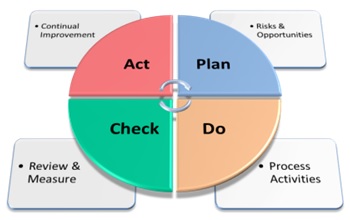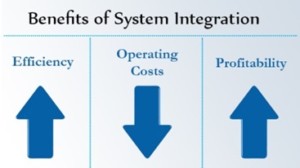What Is an Integrated Management System?
An Integrated Management System (IMS) is a single management system that combines all related processes and components to meet the requirements of more than one management standard into one overarching system designed to be easier to manage and operate. Integration can be executed by an organization of any size, relating to any sector, and is typically done to lower operating costs and simplify a mature management system. These systems have linkages integrated within them that help processes to be managed smoothly and without duplication.
An integrated audit assesses an integrated management system with the same set of documentation, policies, processes, and procedures. This can lead to a lower certification cost as well as fewer interruptions to the organization itself.
Benefits of Integrated Management Systems
By implementing more than one standard within one overarching integrated system, businesses can develop a mutual or single management system component such as policies, objectives, resources, or processes and integrate their processes, saving organizations time and money.
As individual systems are integrated to show a coherency between their objectives, processes, and resources, there is an improvement in accountability and responsibility. Using integration to create a sense of consistency in one’s organization allows the system to become less complex and more easily understood by interested parties. Consistency also helps establish a mutual set of objectives that are important to the organization.
Integration also eliminates redundancy by taking a systematic approach towards decision-making. This is usually not the case when management standards are implemented due to the layers of hierarchy and inability to streamline decisions. As the processes become better equipped to accommodate change, we often see a reduction in bureaucracy.
Establishing cross-functional teams and merging them with process owners can make decision-making and deployment easier. Integrated management systems also allow organizations to conduct integrated audits and assessments, which help with time management and reduce costs.
Auditing Multiple Standards Utilizing Integrated Audits
Integrated audits can lead to fewer work floor interruptions, more streamlined processes, and better consistency with objectives across various systems. An organization can also theoretically save time by having a single audit for multiple certification standards, which may be a cost saving alternative to booking multiple auditors for multiple audits.
This however will depend on the capacity and capabilities of your Certification Body. One saving that could be of benefit to your organization is with integrating audits, your employees only need one stretch of time booked to accommodate the audit, compared to potentially two or three separate occasions for multiple audits over an extended period of time if you have not integrated your system and audits.
Even if it is time conserving, audit time depends on the extent of the integration of the management system and its documentation, the capability of the auditees to provide information on multiple system standards and lastly, the availability of auditors that can audit integrated systems.
Planning Integrated Audits & Schedules
When planning an integrated audit, your organization should focus on a single audit plan and create an audit matrix that clearly shows all the subsections of the different management systems. It should include the processes within the scope of the audit and address the applicable standard requirements during the assessment of these processes. Due to the common requirements throughout some standards, integrated audits can cover multiple standards at once when looking at certain aspects of your company and its processes. For example, internal audit and management review requirements are common to all management standards and would only need to be audited once during an integrated audit.
The audit team as a whole must satisfy the competence requirements as relevant for each management system standard covered by the scope of the audit of an IMS.




 “a mind-set present when certain departments or sectors do not wish to share information with others in the same company. This type of mentality will reduce efficiency in the overall operation, reduce moral, and may contribute to the demise of a productive company culture.”
“a mind-set present when certain departments or sectors do not wish to share information with others in the same company. This type of mentality will reduce efficiency in the overall operation, reduce moral, and may contribute to the demise of a productive company culture.”
 ent systems then it’s at this point they can start to see the real benefits.
ent systems then it’s at this point they can start to see the real benefits. Annex SL is an ISO document that defines a high level structure [HSL] for the framework of a generic management system.
Annex SL is an ISO document that defines a high level structure [HSL] for the framework of a generic management system.